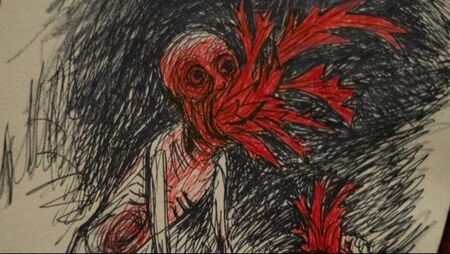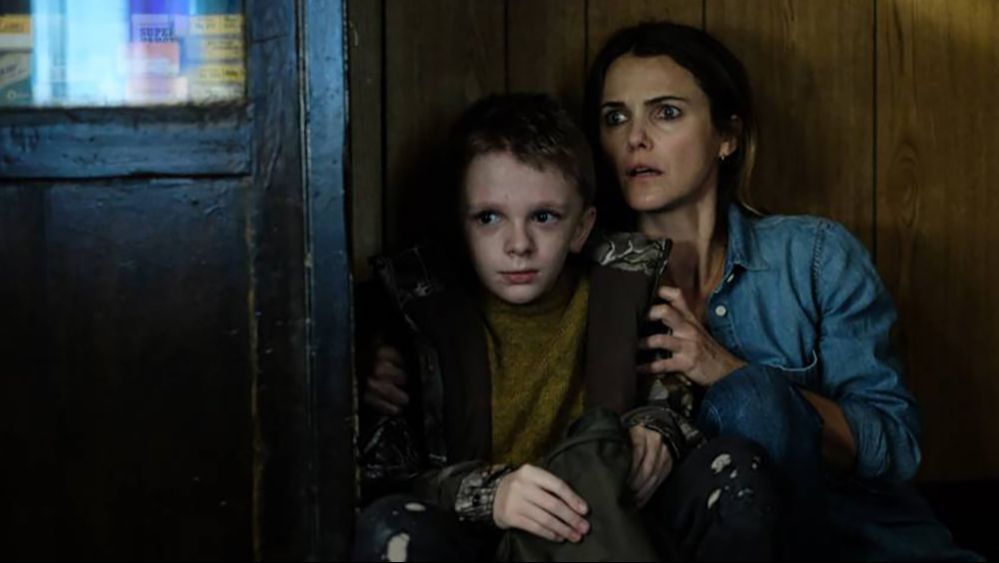 You know what creature we don’t see enough of in horror? The Wendigo… …Originating from the folklore of indigenous people, the Wendigo is an evil, ancestral spirit that has rarely seen the spotlight in film outside of subtle mentions in Stephen King’s Pet Sematary, a portion of Larry Fessenden’s work, and a few others. Which is too bad, because it’s a fascinating creature. With Antlers, which just premiered at Beyond Fest, director Scott Cooper (Black Mass) has delivered the most terrifying film to date revolving around the Wendigo. Written by Cooper, Henry Chaisson and Nick Antosca (“Channel Zero”), Antlers follows a middle school teacher named Julia (Keri Russell), back home and staying with her sheriff brother, Paul (Jesse Plemons) while she recoups from a traumatic past. After some warning signs in class, Julia begins to suspect that her student, Lucas (Jeremy T. Thomas) is experiencing abuse at home. But Julia soon learns that what’s tormenting Lucas isn’t exactly human. Prepare yourselves, because Antlers is as grim as grim gets. Cooper and composer Javier Navarrete set a dread-filled tone with an opening that pans across the mist-covered town in which the film takes place. It’s the sort of industrial town that feels like its been left behind by the world, where rust covers every inch of the decrepit houses that line quiet streets. It’s the kind of place where, as we soon learn with Lucas’ father Frank (Scott Haze), is home to addicts and meth dealers. And as Frank comes to unfortunately realize while cooking some meth with his buddy in an abandoned warehouse, it’s a place where monsters of all types roam. Through long takes, an unnerving sound design, and Florian Hoffmeister’s grey, bleak as hell cinematography, Antlers is the sort of film that swims in your gut like a bad stomach bug. Every shot is wrapped in darkness. The ominous feeling which Cooper builds is inescapable. All of that allowing for scares to come more suddenly and viciously when least expected. I’d be lying if I said Antlers didn’t knock a few screams out of me, it does that good of a job of lulling the audience into a dreary state before coming out swinging. Needless to say, Antlers is not a happy film. Around every corner is one tragic, ugly reveal after another. Lucas and Julia share a direct connection in their experience with abuse, Julia’s past still haunting her and Lucas’ present scarring him. Much of the first half of Antlers is getting deep in the mud with Lucas as he scrounges for roadkill and cuts up animals to feed to--something—in his attic. Keep in mind, this kid is about 12, and a very fragile looking 12 at that. Meanwhile, Julia is fighting her alcoholism while trying to reconnect with Paul and experiencing living nightmares of the violence she suffered at the hands of her father. Both characters don’t need dialogue to express how awful they’re doing, either. I mean this as a compliment, but Keri Russell has that perfect “troubled” look that she brings to the character—along with a makeup job that makes it look like she hasn’t sleep in weeks—and there’s a heartbreaking sadness to her that allows for it to make sense when she decides it’s her job to help Lucas. Lucas, on the other hand, is skin and bones, covered in dirt, and portrayed with an on-edge demeanor by Jeremy T. Thomas that translates the fear from Lucas into your bones. Before my screening, director Scott Cooper made a comment that some of the younger actors didn’t always understand what was real and what wasn’t, and that terror is present in Lucas in every scene. The point of all of this is to say is that Antlers dives deep into the bleak end of the pool and deals with a variety of tough subject matter that won’t be easy for everyone to stomach. Cooper’s direction is superb, the performances are all genuine and believable, but the real star of the show—true to most monster movies—is the effects team. Antlers contains one of the hands down best creatures of the year, presented in both practical and digital effects (that’s a big deal to us nerds). Remember the creature from David Bruckner’s The Ritual? Well, Antlers beasty doesn’t look the same, but it does give that same jaw-dropping, stunned horror sort of feeling that will have it burned into your mind for weeks. And that’s before it goes all Texas Chainsaw Massacre on us (you’ll see). That’s not even mentioning the rest of the grotesque carnage running rampant through the film. Antlers has everything from cannibalism to shredded bodies and a wicked transformation scene that’ll choke your screams like antlers in your throat. This is no trophy buck, though. For one, Antlers is more or less your basic monster movie. It’s full of characters doing outrageously stupid things, which always works better in campier fare instead of tales like this that are meant to feel more real and less silly. The lore is also a bit hand-wavey, expressed in vague detail through a scene in which the town’s one indigenous person, Warren (Graham Greene), shows up just to be the magical Native American trope and tell our characters everything they need to know about their little monster problem. People, it’s 2021, we have to stop doing this. The third act also stampedes along so quickly to a shoulder shrug of a finale that it gets lost in the trees and struggles to maintain the bristling suspense that otherwise permeates throughout. I can’t forget to mention that Antlers is produced by Guillermo del Toro, because he was attracted to the idea of a monstrous fable of the earth with real meaning, and is a monster kid at heart himself. Well, for all of its flaws, Antlers is a film with a vibrant heart that burns bright in the darkness. There’s a coldness to the characters because of what they’ve been through, but their passion to love or be loved is endearing enough to pull the audience closer through the traumatic forest which Antlers runs through. This one should appeal to all monster kids at heart, just don’t expect it to trample your expectations. Antlers comes to theaters on October 29th from Searchlight Pictures. By Matt Konopka
1 Comment
10/23/2021 01:31:41 am
ore importantly, your personal experience mindfully using our emotions as data about our inner state and knowing when it’s better to de-escalate by taking a time out are great tools. Appreciate you reading and sharing your story since I can certainly relate and I think others can to
Reply
Leave a Reply. |
Archives
March 2023
|


 RSS Feed
RSS Feed